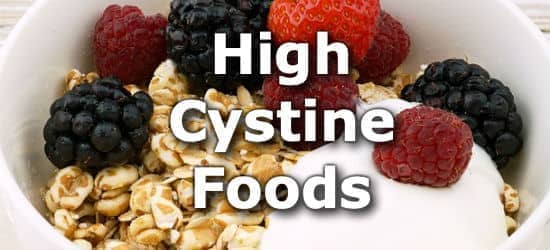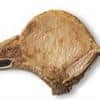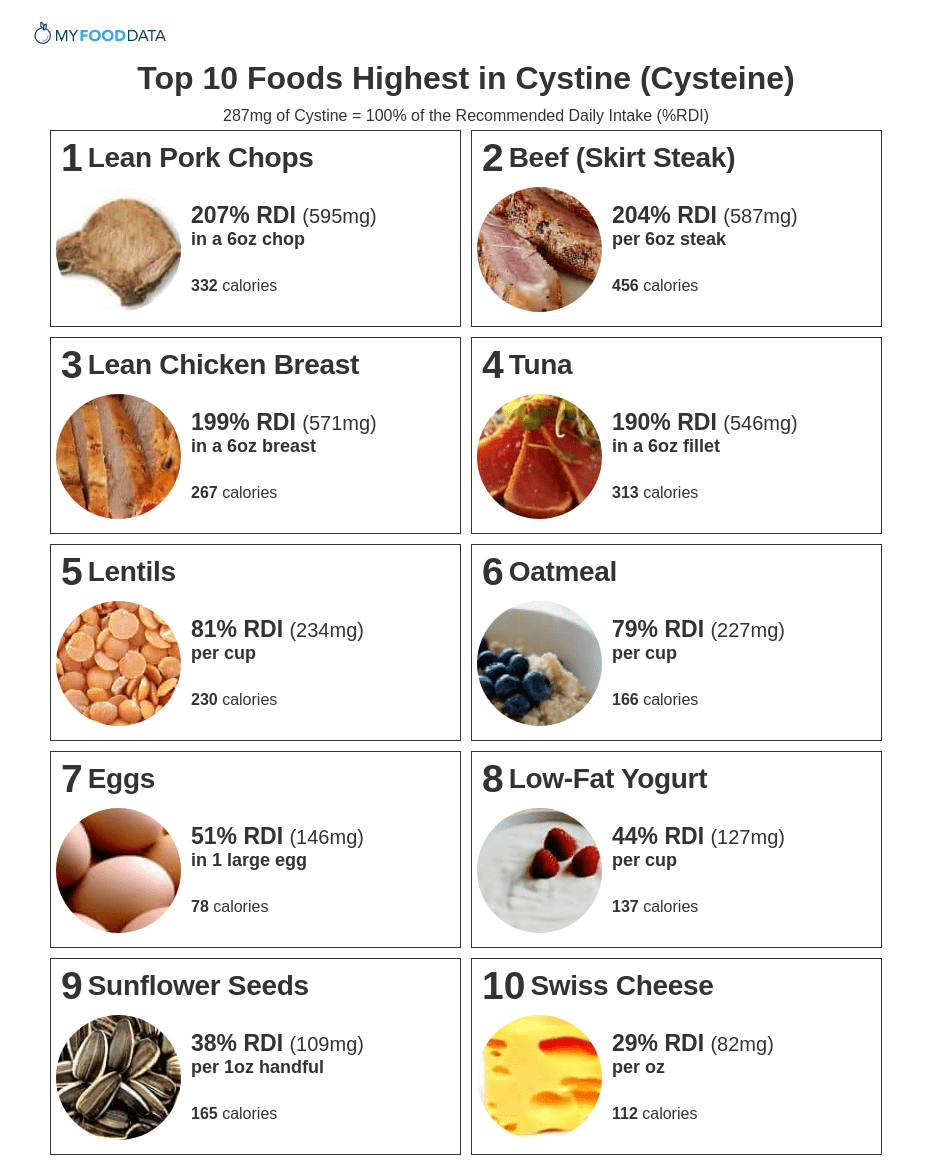Top 10 Foods Highest in Cystine (Cysteine)

Cysteine is an amino acid, and is used by the human body to make proteins. Cystine is the oxidized dimer form of cysteine, meaning that it’s composed of two cysteine molecules bonded together. It is considered nutritionally equivalent to cysteine, and is the major form in which this amino acid is transported in the bloodstream. (1,2,3)
Among its many functions, cystine helps to create anti-oxidants such as glutathione (4), and is also used in the synthesis of other molecules within the cell.
Cysteine or cystine supplementation is sometimes used for various reasons, including to help with hair health, skin health, liver health, immune system function, and even to delay aging. However, current scientific evidence does not strongly support these claims. Although some studies have found benefits, others have found no effect or harmful effects from cystine supplementation. (5)
High cystine foods include pork, beef, chicken, fish, lentils, oatmeal, eggs, low-fat yogurt, sunflower seeds, and cheese. The reference dietary intake (RDI) for cystine is 4.1mg per kilogram of body weight or 1.9mg per pound. A person weighing 70kg (~154 pounds) should consume 287mg of cystine per day. (6)
Below is a list of the top 10 foods highest in cystine with the %RDI calculated for someone weighing 70kg (154lbs). For more high cystine foods see the extended list of cystine-rich foods.
List of High Cystine Foods
-
 1. Lean Pork Chops + Add
1. Lean Pork Chops + Add
Cystine
in a 6oz ChopCystine
per 100gCystine
per 200 Calories595mg
(207% RDI)350mg
(122% RDI)359mg
(125% RDI)More Pork High in Cystine
- 176% RDI per cup of roast ham
- 32% RDI per 3oz sausage link
- 28% RDI per oz of salami
See all meats high in cystine.
-
 2. Beef (Skirt Steak) + Add
2. Beef (Skirt Steak) + Add
Cystine
per 6oz SteakCystine
per 100gCystine
per 200 Calories587mg
(204% RDI)345mg
(120% RDI)257mg
(90% RDI)More Beef and Lamb High in Cystine
- 126% RDI per 3oz of lamb roast
- 99% RDI per 3oz buffalo roast
- 92% RDI per 3oz of beef roast
See all meats high in cystine.
-
 3. Lean Chicken Breast + Add
3. Lean Chicken Breast + Add
Cystine
in a 6oz BreastCystine
per 100gCystine
per 200 Calories571mg
(199% RDI)336mg
(117% RDI)428mg
(149% RDI)More Poultry High in Cystine
- 258% RDI per chicken leg
- 198% RDI in 6oz of ground turkey
- 125% RDI in a roast chicken thigh
See all meats high in cystine.
-
 4. Tuna + Add
4. Tuna + Add
Cystine
in a 6oz FilletCystine
per 100gCystine
per 200 Calories546mg
(190% RDI)321mg
(112% RDI)349mg
(122% RDI)More Fish High in Cystine
- 222% RDI in 20 small clams
- 175% RDI per 6oz salmon fillet
- 157% RDI per 6oz tilapia fillet
See all fish and shellfish high in cystine.
-
 5. Lentils + Add
5. Lentils + Add
Cystine
per CupCystine
per 100gCystine
per 200 Calories234mg
(81% RDI)118mg
(41% RDI)203mg
(71% RDI)More Beans High in Cystine
- 161% RDI per cup of boiled soybeans (edamame)
- 87% RDI per cup of split peas
- 68% RDI per cup of chickpeas (garbanzo beans)
-
 6. Oatmeal + Add
6. Oatmeal + Add
Cystine
per CupCystine
per 100gCystine
per 200 Calories227mg
(79% RDI)97mg
(34% RDI)273mg
(95% RDI)More Whole Grains High in Cystine
- 75% RDI per cup of kamut
- 51% RDI per cup of whole wheat pasta
- 32% RDI per cup of rice
See all grains high in cystine.
-
 7. Eggs + Add
7. Eggs + Add
Cystine
in 1 Large EggCystine
per 100gCystine
per 200 Calories146mg
(51% RDI)292mg
(102% RDI)377mg
(131% RDI) -
 8. Low-Fat Yogurt + Add
8. Low-Fat Yogurt + Add
Cystine
per CupCystine
per 100gCystine
per 200 Calories127mg
(44% RDI)52mg
(18% RDI)186mg
(65% RDI)- 36% RDI per 16oz glass of milk
See all dairy foods high in cystine.
-
 9. Sunflower Seeds + Add
9. Sunflower Seeds + Add
Cystine
per 1oz HandfulCystine
per 100gCystine
per 200 Calories109mg
(38% RDI)383mg
(133% RDI)132mg
(46% RDI)More Nuts and Seeds High in Cystine
- 66% RDI per oz of hemp seeds
- 40% RDI per oz of chia seeds
- 36% RDI per oz of cashews
See all nuts and seeds high in cystine.
-
 10. Swiss Cheese + Add
10. Swiss Cheese + Add
Cystine
per OzCystine
per 100gCystine
per 200 Calories82mg
(29% RDI)290mg
(101% RDI)148mg
(51% RDI)More Cheese High in Cystine
- 43% RDI per 1/2 cup of ricotta
- 30% RDI per oz of gruyere
- 25% RDI per oz of gouda
See all dairy foods high in cystine.
Printable One Page Sheet

More Cystine Rich Foods
| Food | Serving | Cystine |
|---|---|---|
| 1. Beef Liver + | 1 slice | 135% RDI (388mg) |
| 2. Somen Noodles + | per cup | 69% RDI (199mg) |
| 3. Teff + | per cup | 61% RDI (174mg) |
| 4. Couscous + | per cup | 59% RDI (168mg) |
| 5. Firm Tofu + | per cup | 50% RDI (144mg) |
| 6. Crab Cakes + | per cake | 50% RDI (143mg) |
| 7. Lima Beans + | per cup cooked | 49% RDI (141mg) |
| 8. Carrots + | per cup chopped | 21% RDI (60mg) |
| 9. Shiitake Mushrooms + | per cup cooked | 14% RDI (39mg) |
| 10. Almond Butter + | per tblsp | 13% RDI (39mg) |
From the Nutrient Ranking Tool
Use the ranking tool links below to select foods and create your own food list to share or print.
- Foods High in Cystine
- Foods Low in Cystine
- Vegetables High in Cystine
- Fruits High in Cystine
- Vegetarian Foods High in Cystine
- Nuts High in Cystine
- Grains High in Cystine
- Beans High in Cystine
- Dairy High in Cystine
- Breakfast Cereals High in Cystine
- Fast Foods High in Cystine
View more nutrients with the nutrient ranking tool, or see ratios with the nutrient ratio tool.
Related
Data Sources and References
- Cunden LS, Nolan EM. Biochemical and Functional Evaluation of the Intramolecular Disulfide Bonds in the Zinc-Chelating Antimicrobial Protein Human S100A7 (Psoriasin) Methods Mol Biol. 2019;1929:379-395. doi: 10.1007/978-1-4939-9030-6_24. 30710286
- Kapoor V, Glover R, Malviya MN. Cysteine, cystine or N-acetylcysteine supplementation in parenterally fed neonates Cochrane Database Syst Rev. 2015 Dec 2;2015(12):CD009172. doi: 10.1002/14651858.CD009172.pub2. 26630252
- Noda T, Iwakiri R, Fujimoto K, Rhoads CA, Aw TY. The Non-Essential Amino Acid Cysteine Becomes Essential for Tumor Proliferation and Survival Cell Prolif. 2002 Apr;35(2):117-29. doi: 10.1046/j.1365-2184.2002.00229.x. 11952646
- Sakanashi M, Sakanashi M, Sugahara K, Sakanashi M. Mechanisms underlying the cardioprotective effect of L-cysteine Clin Exp Pharmacol Physiol. 2007 Jan-Feb;34(1-2):55-60. doi: 10.1111/j.1440-1681.2007.04543.x. 17201736
- Mohammadi H, Farzinpour A, Vaziry A. Effects of the Usage of l-Cysteine (l-Cys) on Human Health Reprod Domest Anim. 2017 Apr;52(2):298-304. doi: 10.1111/rda.12902. Epub 2017 Jan 20. 28109029
- World Health Organization - Protein and Amino Acid Requirements In Human Nutrition
Simplify Nutrition Tracking with MyFoodData!
Speedy Tools and Detailed Data FREEEasily analyze your meals to find the best foods for your goals.
✅ Use our recipe nutrition calculator and nutrition comparison tool.
✅ Access expert nutrition data tools and in-depth articles.
✅ Log foods and organize your recipes with a free account.


 Next ➞
Next ➞
